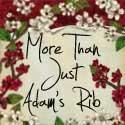I tell him of my friend Jennifer in Iowa and the rains that will come too late for the bounty every farmer desires, of Ann and her husband watching the fields wondering if this year will be the year they won't get the crop in.
He nods his head in understanding and reaches out a long yellow stick to tap one of the black labs sneaking up to steal son's half-eaten peanut butter sandwich.
While crops in other parts of the country have suffered this year from drought, in my family's little patch of Louisiana clay, we've suffered the exact opposite with too much rain.
More than twelve inches during Hurricane Isaac, six more just two weeks before that, and a 40% chance on too many daily forecasts throughout the spring and deep into the summer.
Whether it's too much or too little, the result is the same--a diminished harvest.
A good year with three strong cuttings would yield in excess of 25,000 bales. This year? We'll be blessed to harvest ten.
Come winter, an entire barn whose belly normally swells with the fullness will be empty until at least next summer, maybe longer depending on what God gives.
Still, the harvest is a time of hard work and excitement among my children. Afternoon red wagons are abandoned in front of tall hay stacks and hollow bamboo in hopes of the promised ride around the fields to pick up the leftover hay.
A passerby might look across the newly shorn field and think all is finished. Yet, they would be mistaken.
There is more left to harvest. Do you see?
The twins file into mother-in-law Oma's tractor with the pink license plate and drive to the edges of the fields, baling the remnant that some might just leave. Oldest son shares a cab with his Opa, driving behind the trio to scoop up the few remaining bales spit out in its path.
And then there are the broken bales, the ones where the baling twine snapped, spilling newly-packed hay back to earth in a messy clump.
This, too, is worthy of harvest. It passes through the baler again before being picked up by the stack wagon and tucked away in the barn.
Every time there is a cutting, this scene plays out--the harvest of the many, then the going back to search out the remnant clinging to the fringes, to reclaim what was damaged and lost and then add the late-gathered ones to the overall harvest.
There's no way I can look at this and not see an image of the Father's plan for His harvest.
For Him, like for this farmer's wife, the harvest is not just about the many.
It's also about the broken, the already passed-over...the few.
Writing in Community today with:















The photo of your little red wagon with the hay ... oh such imagery. Reminds me of how we're just hauling what we've got, you know? One little wagon at a time this year.
ReplyDeleteIt warms my heart to think that you spoke of our family, right there, on your family farm. We're linked, sister. Our hearts are so linked.
That little red wagon looked so lonely just sitting there, waiting for its children who are fast outgrowing it. Yes, Jennifer, our hearts echo the beat of the same Father.
DeleteJust wow. I have no words. Powerfully written, yet again.
ReplyDeleteThat's how I feel each I time I see this image. It resonates so much now because I'm deep in Ezekiel where God romps and stomps on sin and then stops always to mention His remnant. He is so merciful.
Delete